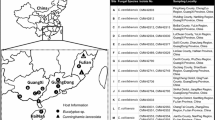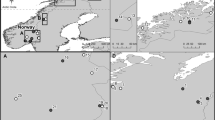Abstract
Ceratocystis spp. include important pathogens of trees as well as apparently saprophytic species. Four species have been recorded on Eucalyptus grandis in Australia, of which only one, C. pirilliformis Barnes and M.J. Wingf., is known to be pathogenic. A recent survey of pests and diseases of Eucalyptus trees in northern Queensland revealed a species of Ceratocystis associated with the tunnels made by the aggressive wood-boring insect Phoracantha acanthocera (Macleay) (Cerambicydae: Coleoptera). The aim of the present study was to identify the fungus based on morphological characteristics and comparisons of DNA sequence data for three gene regions. The fungus peripherally resembles C. fimbriata Ell. and Halst. but differs from this species most obviously by having much darker mycelium, longer ascomatal necks, segmented hyphae and an absence of aleuroconidia. Comparisons of combined sequence data confirmed that the Ceratocystis sp. from P. acanthocera represents an undescribed taxon, which is provided with the name Ceratocystis atrox sp. nov. C. atrox appears to have a close relationship with P. acanthocera, although its role in the biology of the insect is unknown and its pathogenicity has not been considered.
Similar content being viewed by others
References
Abbott I, Smith R, Williams M, Voutier R (1991) Infestation of regenerated stands of karri (Eucalyptus diversicolor) by bullseye borer (Tryhocaria acanthocera, Cerambycidae) in Western Australia. Australian Forestry 54, 66–74.
Baker-Engelbrecht CJ, Harrington TC (2005) Intersterility, morphology and taxonomy of Ceratocystis fimbriata on sweet potato, cacao and sycamore. Mycologia 97, 57–69.
Barnes I, Roux J, Wingfield BD, Dudzinski MJ, Old KM, Wingfield MJ (2003a) Ceratocystis pirilliformis, a new species from Eucalyptus nitens in Australia. Mycologia 95, 865–871. doi: 10.2307/3762015
Barnes I, Roux J, Wingfield BD, O’Neil M, Wingfield MJ (2003b) Ceratocystis fimbriata infecting Eucalyptus grandis in Uruguay. Australasian Plant Pathology 32, 361–366. doi: 10.1071/AP03032
Christiansen E, Solheim H (1990) The bark beetle-associated blue-stain fungus Ophiostoma polonicum can kill various spruces and Douglas fir. European Journal of Forest Pathology 20, 436–446.
Farr JD, Dick SG, Williams MR, Wheeler IB (2000) Incidence of bullseye borer (Phoracantha acanthocera (Macleay) Cerambicidae) in 20–35-year-old regrowth karri in the south-west of Western Australia. Australian Forestry 63, 107–123.
Glass NL, Donaldson GC (1995) Development of primer sets designed for use with the PCR to amplify conserved genes from filamentous Ascomycetes. Applied and Environmental Microbiology 61, 1323–1330.
Jacobs K, Bergdahl DR, Wingfield MJ, Halik S, Seifert KA, Bright DE, Wingfield BD (2004) Leptographium wingfieldii introduced into North America and found associated with exotic Tomicus piniperda and native bark beetles. Mycological Research 108, 411–418. doi: 10.1017/S0953756204009748
Johnson JA, Harrington TC, Engelbrecht CJB (2005) Phylogeny and taxonomy of the North American clade of the Ceratocystis fimbriata complex. Mycologia 97, 1067–1092.
Kile GA (1993) Plant diseases caused by species of Ceratocystis sensu stricto and Chalara. In ‘Ceratocystis and Ophiostoma: taxonomy, ecology, and pathogenicity’. (Eds MJ Wingfield, KA Seifert, JF Webber) pp. 173–183. (APS Press: St Paul, MN)
Kile GA, Harrington TC, Yaun ZQ, Dudzinski MJ, Old KM (1996) Ceratocystis eucalypti sp. nov. a vascular stain fungus from eucalypts in Australia. Mycological Research 100, 571–579.
Marais GJ, Wingfield MJ, Viljoen CD, Wingfield BD (1998) A new ophiostomatoid genus from Protea infructescences. Mycologia 90, 136–141. doi: 10.2307/3761023
Marin M, Castro B, Gaitan A, Preisig O, Wingfield BD, Wingfield MJ (2003) Relationships of Ceratocystis fimbriata isolates from Colombian coffee-growing regions based on molecular data and pathogenicity. Journal of Phytopathology 151, 395–405. doi: 10.1046/j.1439-0434.2003.00738.x
Moller W, DeVay J (1968) Insect transmission of Ceratocystis fimbriata in deciduous fruit orchards. Phytopathology 58, 1499–1508.
Phillips CL (1993a) Forest insects. Longicorn beetles 2. Bulls-eye borer — Tryphocaria acanthocera Macleay. Forest Health fact sheet 18. Available at: http://www.forestry.sa.gov.au [Verified 29 May 2007]
Phillips CL (1993b) Insect pest problems of eucalypt plantations in Australia. 5. South Australia. Australian Forestry 56, 378–380.
Rayner RW (1970) ‘A mycological colour chart.’ (Commonwealth Mycological Institute and British Mycological Society: Kew)
Redfern DB, Stoakley JT, Steele H (1987) Dieback and death of larch caused by Ceratocystis laricicola sp. nov. following attack by Ips cembrae. Plant Pathology 36, 467–480. doi: 10.1111/j.1365-3059.1987.tb02264.x
Roux J, Wingfield MJ, Wingfield BD, Bouillett JP, Alfenas AC (2000) A serious new disease of Eucalyptus caused by Ceratocystis fimbriata in Central Africa. Forest Pathology 30, 175–184. doi: 10.1046/j.1439-0329.2000.00202.x
Roux J, Coutinho TA, Munjuni Byabashaija D, Wingfield MJ (2001) Diseases of plantation Eucalyptus in Uganda. South African Journal of Science 97, 16–18.
Roux J, Van Wyk M, Hatting H, Wingfield MJ (2004) Ceratocystis species infecting stem wounds on Eucalyptus grandis in South Africa. Plant Pathology 53, 414–421. doi: 10.1111/j.0032-0862.2004.01014.x
Swofford DL (2002) ‘PAUP*. Phylogenetic Analysis Using Parsimony (*and other methods). Version 4.’ (Sinauer Associates: Sunderland, MA)
Van Wyk M, Roux J, Barnes I, Wingfield BD, Chhetri DB, Kirisits T, Wingfield MJ (2004a) Ceratocystis bhutanensis sp. nov. associated with the bark beetle Ips schmutzenhoferi on Picea spinulosa in Bhutan. Studies in Mycology 50, 365–379.
Van Wyk M, Roux J, Barnes I, Wingfield BD, Liew ECY, Assa B, Summerell BA, Wingfield MJ (2004b) Ceratocystis polychroma sp. nov. a newspecies from Syzygium aromaticum in Sulawesi. Studies in Mycology 50, 273–282.
Van Wyk M, Roux J, Barnes I, Wingfield BD, Wingfield MJ (2005) Molecular phylogeny of the Ceratocystis moniliformis complex and description of C. tribiliformis. Fungal Diversity 21, 181–201.
Van Wyk M, Van der Merwe NA, Roux J, Wingfield BD, Kamgan GN, Wingfield MJ (2006) Population biology of Ceratocystis fimbriata from Eucalyptus trees in South Africa. South African Journal of Science 102, 259–263.
Wang Q, Thornton IWB, New TR, Wang Q (1999) A cladistic analysis of the phoracanthine genus Phoracantha Newman (Coleoptera: Cerambycidae: Cerambycinae), with discussion of biogeographic distribution and pest status. Annals of the Entomological Society of America 92, 631–638.
Webster RK, Butler EE (1967) A morphological and biological concept of the species Ceratocystis fimbriata. Canadian Journal of Botany 45, 1457–1467.
White TJ, Bruns T, Lee S, Taylor J (1990) Amplification and direct sequencing of fungal ribosomal RNA genes for phylogenetics. In ‘PCR protocols: a sequencing guide to methods and applications’. (Eds MA Innis, DH Gelfand, JJ Sninsky, TJ White) pp. 315–322. (Academic Press: San Diego, CA)
Wingfield MJ, De Beer C, Visser C, Wingfield BD (1996) A new Ceratocystis species defined using morphological and ribosomal DNA sequence comparisons. Systematic and Applied Microbiology 19, 191–202.
Yuan ZQ, Mohammed C (2002) Ceratocystis moniliformopsis sp. nov. an early colonizer of Eucalyptus obliqua logs in Tasmania, Australia. Australian Systematic Botany 15, 125–133. doi: 10.1071/SB00024
Author information
Authors and Affiliations
Corresponding author
Rights and permissions
About this article
Cite this article
van Wyk, M., Pegg, G., Lawson, S. et al. Ceratocystis atrox sp. nov. associated with Phoracantha acanthocera infestations on Eucalyptus grandis in Australia. Australasian Plant Pathology 36, 407–414 (2007). https://doi.org/10.1071/AP07042
Received:
Accepted:
Issue Date:
DOI: https://doi.org/10.1071/AP07042




